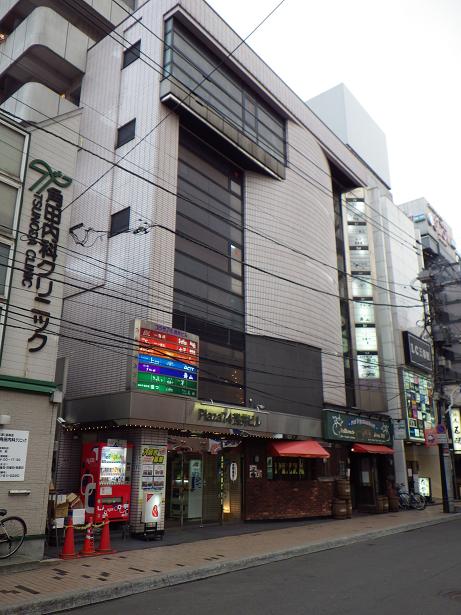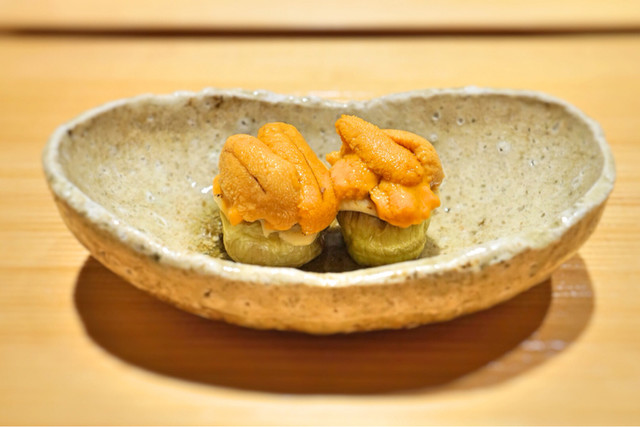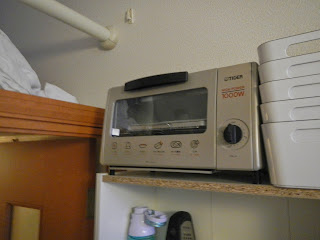Hey all,
(seems like a weird way to start a post nobody will ever read, but this is the easiest way for me to keep track of this if I want to look it up later)
Erm, yes, as the parenthetical implies, I'm writing this up only for my own records, rather than keep it as scribbles in my notebook. Just seemed like a convenient place to put it where it will be accessible for me. If you have come across this for any other reason, uhh, I guess you can enjoy a discussion of a meal you didn't eat that doesn't contain any pictures? (pictures are lame)
So yup, Denkushiflori. The brianchild teamup of the chefs behind Den and Florilège, #3 and #7 on Asia's Top 50 2020 (and the highest ranked Japanese and French restaurants, respectively, make of that what you will). The "theme" they settled on was kushi, or bamboo skewers, and ever dish except the dessert was centered around it. While this is certainly an aesthetic choice, it is also simultaneously a whimsical note to tie everything together and somewhat of a driving force behind the creation of the menu and the cooking methods. They bought into the concept, the highest possible form they could imagine of things cooked on skewers. And it worked
That said, the other theme that was resoundingly present was that of duality. Whether intentional or not (though with these guys, I highly doubt anything on the menu is unintentional), the dishes had contrasting elements deliberately playing off of each other. No dish had a single flavor without a contrasting flavor to balance it, and while individual elements can be classified as "a French take on a Japanese dish" or "French techniques with Japanese ingredients" or whatever, each dish (let alone the course as a whole) contained so much as to defy categorization so easily. But I'll try, I guess, as I keep typing
The décor was modern Japanese, with dark walls and dark wood, but with a modern shape--nothing but straight lines and right angles, giving the space a clean finish. The soundtrack was quite predictably lounge-style covers of Western pop songs (it's a thing at fine dining restaurants in Tokyo, I've come to accept that) from "Here Comes the Sun" to "Like a Virgin" to "Californication"--the version of "Killing Me Softly" only had the female vocalist, but I hummed "one time, one time" under my breath, I don't think anyone noticed. The food, as I said, was superb
The first course started out exactly as they mean to proceed: A boudin noir (blood sausage) lightly breaded in panko and fried, although not at all oily. It was served alongside Aomori apples sliced paper-thin and marinated in sweetened vinegar as a play on pickled ginger and an artful dollop of very spicy mustard. It worked out precisely as you'd expect, with the decadent richness of the sausage cut by the apple, and nose-clearing jolts of mustard clearing the palette every bite. The pairing was a glass of Brut, because of course it was, if there hadn't been a pairing that's what I'd have ordered anyways. Rich to start the course, but they decided not to pull any punches and I thank them for it
Second was what I've seen is often highlighted as one of the features of the menu: A iwashi namatsukune, grilled to perfection, set alongside a chicken liver mousse. Salted kelp and lemon powder on the mousse brightened it while also tying it to the fish--we were instructed that we were allowed to eat them either separately or together. I wish the English language had better words to describe this stuff, because while the word "rich" applies to both the sardine and the mousse, somehow they were different types of richness, complimentary and forming a sum greater than their parts. The pairing as well was absolutely fascinating, as the hostess brought me a glass of Tuscan white. While it was a delightful wine that I would gladly drink by the carafe, I was surprised that they chose something so dry (again, not complaining, I love dry white wine)--I was expected something much sweeter to set off the mousse. And then, sure enough, the second drink pairing arrived, a cocktail combining Okinawan citrus and vodka. Top to bottom, they put thought into the disparate elements of this dish coming together. Absolute masterclass
(side note, but amusing to recall, I took one smell of the cocktail and asked, <is this sweetened with Cointreau?>. The hostess laughed like I'd done a magic trick and told me I was correct. I just demurred politely, まあね. The "trick" of course was just that I had already been musing that the dish needed a drink slightly sweet to cut the mousse especially, and that these were chefs, not cocktail bartenders--so given the French influence on the menu and assuming they'd go with the simplest choice, Cointreau was a pretty easy guess for their choice of sweetener. Part of the secret to get people going, "wow Noah, you know so many random things!" is that I just pass of educated guesses confidently--if I'm right, I look like a wizard; if I'm wrong, oh well everyone makes mistakes)
(another side note, these first two dishes were served on the same plates: Pure white, perfectly circular, completely flat. I assume this was a deliberate choice specifically calculated to make my mother in particular worried, dishware fanatic that she is. Don't worry, Mom, they brought out far more interesting dishware for the subsequent courses)
The third dish was a surprise: Bouillabaisse, completely oldschool style. The traditional orange-pink color, and even though this was a fancy restaurant that could have served a perfectly clear refined broth, they brought it out with the proper cloudiness (cuz, you know, the boill-ed it and then abaisse-d it). It was warm and decadent with just a hint of saffron and I can only imagine how many exotically delicious types of fish involved, with just a few drops of bright green scallion oil. Rather than the toast, they served it with skewered and grilled ebi-imo (lit. shrimp-potato, no actual shrimps were involved in the making of this taro root that just happens to be the shape of a shrimp) which had the perfect little crispness of a grilled (probably deep-fried first) potato on the outside and warm but dense taro texture on the inside. But bringing it back home, yes, they served it with a completely traditional rouille, just a little thicker than a mayonnaise and so good I licked the spoon when nobody was looking. Yet, my favorite part of the dish was the pairing--they paired the most classically French dish on the menu with a glass of nihonshu, just to fuck with us. And obviously it worked, everyone knows that nihonshu is criminally underrated and belongs on any pairing list to go with seafood of any preparation. Well done, very well done
The fourth dish brought it down a little bit back to more predictable territory, certainly not in a bad way: Ganmo (uhh, tofu cake, I guess? There's not a good way to translate how tasty this traditional Japanese dish is) skewered, grilled, and with a few dollops of lemony mayo. It was served on a bed of shredded carrots which you just knew were going to be lightly pickled with a touch of curry, and that's exactly what you got. But the care with which they assembled this dish shone through in every aspect, from the masterful touch necessary to make a simple food like ganmo, to precision with which the chefs tweezered pieces of thyme onto the nest of carrots (I was sitting right in front of the final staging area, which was amazing--I asked what my seat number was so that I can request it next time I go). But, lest anybody think that they were getting too traditional, the pairing was a tequila highball, just a nice silver tequila and soda. Bright and effervescent, this whole dish was a palette cleanser that led into the final round
The fifth dish was what most would consider the main, and it was an absolute treat: Grilled squab and botan ebi, skewered squab-shrimp-squab and grilled over charcoal. The squab was a bit dry, as squad usually is, but still hahahaha obviously I'm kidding, it was moist and absolutely delicious. Ruby red and just a touch sweet from the miso marinade, the squab was perfection and the soft texture paired perfectly with the soft snap of each bit of shrimp. They pulled out all the stops on this one, with a dollop of pigeon liver mousse (amazing) and green onion sauce (how did they do it, I accept I will never know). Not only that, but the served it with a cup of handmade pasta served in a pigeon broth, a nod to the chef's (the two master chefs' protégé) background in Italian cuisine. Looking like a cup of soba bust tasting like the perfect pasta in brodo, it rounded out a dish that felt like a high-wire balancing act of stumbling from one amazing bite to the next. Oh and with a rosé from Hokkaido of all places to stand up to the squab, blend with the shrimp, and brighten up the pasta . . . I already used the word "perfection" in this paragraph but it's hard to think of any other words
The sixth dish was fun: A warm egg custard, cooked French-style, with a turnip purée on top. Though French in conception, this was quite obviously a chawan mushi, traditional Japanese steamed egg custard. The kushi on this was fascinating, a ball of buffalo mozzarella (obviously house-made, with a wonderful texture you don't get otherwise) placed gently into the cup. Warm and creamy and perfect, this dish was just giving you a hug as we meandered to the final bit of the meal. The pairing was a crisp and clean nihonshu from Kyoto, which just put a smile on my face. Because that's what that dish was about
The seventh dish, and final savory dish, was the one I sheepishly admitted to the chef was my favorite: The clay pot rice. At Den (and at most high-end Japanese places) the final dish of the course is always some kind of rice dish, usually this style of clay pot rice with whatever the chef can create. I'm a simple guy at heart, and a no matter what else is put in front of me, there's a good chance that the bowl of rice will be the highlight. Although when the bowl of rice has chunks of duck breast braised in red wine and the finest green onions out there mixed into it, and is topped with a softboiled egg (marinated in soy sauce and then skewered and grilled) . . . I'm not at all ashamed to admit that I'll be dreaming of that dish. Let me say it again. Clay pot rice, cooked to an al dente that preserved each grain distinctly, with chunks of duck and green onions and a egg yolk gently spreading across it . . . and a big glass of a very full-bodied red wine. Yes. I could eat that every day of my life. For breakfast. I'm not at all ashamed
And finally, dessert: They call it a pudding, but it's a flan in the finest sense. I don't typically like sweet things all that much, and it was like they designed this dessert just for me. A firm texture on the flan and not too much sugar, covered in a deeply bitter burnt sugar syrup and whipped cream infused with sencha (with a few leaves on top, for good measure). This dessert was deeply, aggressively, audaciously bitter in its accents, and after the full course of rich and decadent savory dishes, it was exactly how I wanted it to end. Plus a nice glass (ok I had a few) of roasted green tea. And there we had it. Stuck the landing, of course
And so. I'm typing this up at home, enjoying a glass or two of some very nice whiskey that I drink when I'm feeling like the evening deserves a nice whiskey. This evening deserves a nice whiskey
This was an ambitious project. Their stated goal was to do something fun and accessible, bring some fine dining to everyone in the midst of a tough year, and just enjoy themselves. Between the menu and the price point (no really, all told it was less than $150 including the drink pairing, which at 4,500yen for 8 drinks is shamefully good value. I told the chef that he was not charging enough for the drinks, but I hope he doesn't listen)
I'll probably head back in the springtime for their new menu ;)
Noah out
























